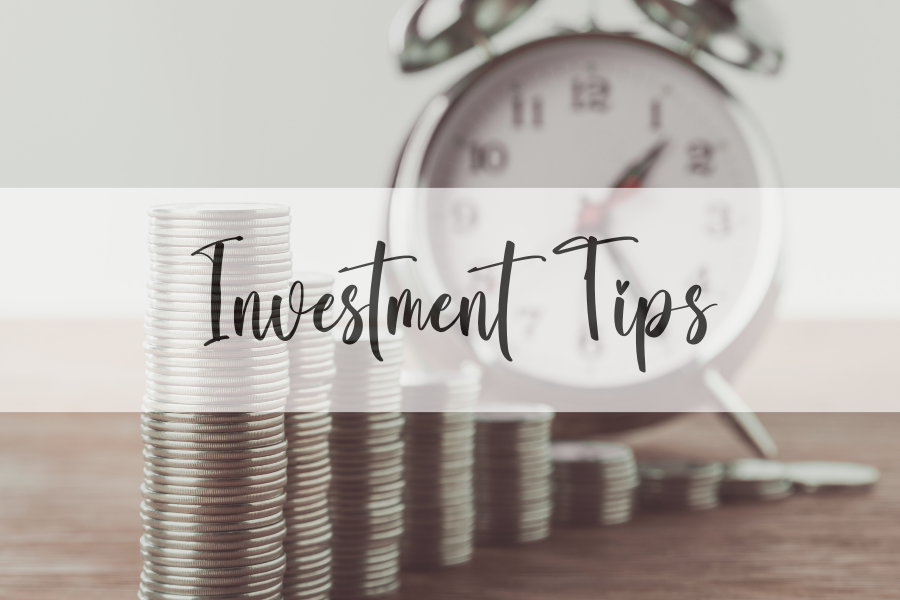This article may contain affiliate links. See our disclaimer for more information.

These are the top investment tips to help navigate the market and boost your financial portfolio. I have compiled the top investment tips that will help you achieve your financial goals and make your money work for you.
Whether you are a first-time investor or a seasoned pro, these finance tips will guide you on your journey towards financial growth and security. Investing money can be daunting, but with the right strategies and knowledge, you can achieve your investment goals with confidence.
From setting financial goals to researching investment options, diversifying your portfolio, and seeking professional advice, this article covers everything you need to know to make informed investment decisions. Follow these investment tips, and you’ll be on the path to financial success in no time.
Reasons to Invest

Investing for beginners can seem daunting, but it’s essential for financial growth and security. Here are some top reasons why you should consider investing your money:
- Build wealth: Investing can help you grow your money steadily over time. With the right investment strategy, you can potentially earn higher returns than traditional savings accounts or bonds.
- Beat inflation: Inflation can eat away at the purchasing power of your money over time. Investing in assets that outpace inflation can help you maintain and even increase your buying power.
- Meet financial goals: Whether you’re saving for retirement, a down payment on a house, or a child’s education, investing can help you reach your goals faster than relying solely on savings or income.
- Diversify your portfolio: Investing in a variety of assets can help you spread out risk and reduce the impact of any single asset’s poor performance on your overall portfolio.
- Take advantage of tax benefits: Certain investment vehicles, such as retirement accounts, offer tax benefits that can help you save money on taxes.
By understanding the benefits of investing, you can start to see how it can play a crucial role in your financial future.
Setting Financial Goals

Setting financial goals is a crucial step towards successful investing. As an investor, it’s essential to have clear objectives that guide your investment decisions. Financial goals can help you define your investment horizon, risk tolerance, and return expectations, amongst other things.
When setting financial goals, it’s best to start with your long-term objectives. Do you want to save for retirement, buy a house, or fund a child’s education? Once you have your long-term goals in mind, you can set short-term objectives that align with your overall plan.
It’s important to make your goals specific, measurable, achievable, relevant, and time-bound (SMART). For example, instead of setting a goal to “save money,” set a SMART goal to “save $10,000 in 12 months for a down payment on a house.” This goal is specific, measurable, achievable, relevant, and time-bound.
As you set your financial goals, keep in mind the investment strategies that align with them. For instance, if your goal is to save for retirement, a long-term investment strategy with a focus on income-generating assets, such as dividend-paying stocks and bonds, may be suitable. On the other hand, if you’re saving for a short-term goal, such as buying a car, a short-term investment strategy with a focus on less volatile assets, such as money market funds, may be appropriate.
Setting financial goals is a critical component of successful investing. By setting SMART goals, you can make informed investment decisions that align with your long-term objectives. Keep in mind the investment strategies that align with your financial goals and adjust your objectives as needed to stay on track.
Understanding Risk and Return

Keep in mind as you read these investing tips that investing involves risk. It’s important to understand the relationship between risk and return. The higher the potential return of an investment, the higher the risk involved. Conversely, investments with lower risk tend to have lower potential returns. Because of this it’s crucial to balance risk and return within your investment portfolio.
Investment Risk
Investment risk is the possibility of losing money on an investment due to factors such as market fluctuations, economic downturns, or company-specific issues with any stock you may have purchased. The level of investment risk varies depending on the type of investment and its underlying assets.
It’s important to note that all investments involve some degree of risk, and it’s essential to assess the risk associated with each investment before making a decision.
Investment Return
Investment return refers to the gain or loss on an investment over a specific period. A higher return means more significant gains, while a lower return means smaller gains or even losses. Different investment vehicles have varying potential returns.
To maximize your returns, it’s important to balance risk and return within your portfolio. Investing in higher risk investments may offer higher returns, but a portfolio concentrated in high-risk investments can be more volatile and result in significant losses. Be sure to fully understand what you’re investing in and what the risks are.
Diversification Strategies

Investing in a single asset or sector can lead to higher risk and lower returns. That’s why diversification is a key strategy for building a balanced investment portfolio. You can diversify your portfolio by spreading your money across various assets including:
- Stocks – a share of part of a company which pays out earnings in the form of dividends
- Bonds – a loan to governments or corporations who pay you back the face value plus accrued interest after an agreed upon amount of time
- Real Estate – Either through investing directly in property or in a Real Estate Investment Trust (REIT), this is investing your money in real, physical properties
- Commodities – basic goods such as gold, silver, oil, gas and wheat
Investing in these different assets classes will help reduce the risk of losing money.
Related article: Why You Should Invest in Real Estate: Smart Moves to Prosper
Benefits of Diversification
Diversification can help you minimize risk and maximize returns. It allows you to spread your investments across various industries and asset classes, reducing the impact of a single asset’s performance on your portfolio. By diversifying your investments, you can potentially earn higher returns while reducing the overall risk of your portfolio.
Types of Diversification Strategies
There are several ways to diversify your investment portfolio:
- Asset allocation: Spreading your investments across asset classes such as stocks, bonds, and cash.
- Industry diversification: Investing in various industries, such as technology, healthcare, and finance.
- Geographic diversification: Investing in different geographical regions to mitigate the risks associated with investing in a single country or region.
- Investment style diversification: Investing in both growth and value stocks, as well as small and large-cap stocks.
When to Rebalance Your Portfolio
Our next financial tip is to periodically rebalance your portfolio. This is an important step to maintaining a diversified portfolio. Rebalancing involves reviewing your investments and adjusting the allocation of assets to align with your investment goals and risk tolerance. Rebalancing can help you stay on track with your investment plan and prevent your portfolio from becoming too heavily weighted in one asset class. It is also a good time to review to see if you may have some investments performing poorly that it would be best to allocate to another fund.
Researching Investment Options

Before making any investment decisions, it is crucial to conduct thorough research. Without proper research, you risk making poor investment decisions that could cost you financially. Here are some tips on how to research investment options effectively:
- Understand the Different Types of Investments
Before beginning your research, it is essential to understand the different types of investments available. This will help you to determine which investments align with your financial goals and risk tolerance. Common types of investments include stocks, bonds, mutual funds, exchange-traded funds (ETFs), and real estate.
- Analyze Market Trends
Market trends can have a significant impact on the performance of your investments. Analyzing market trends can help you to identify opportunities and make informed investment decisions. You can use a variety of resources to gather information on market trends, including financial news outlets, industry publications, and expert analysis.
- Study Financial Statements
When researching individual stocks or mutual funds, it is crucial to study their financial statements. Financial statements provide valuable information about a company’s financial health, including revenue, expenses, and debt. You can find financial statements on the company’s website or through the Securities and Exchange Commission’s (SEC) online database.
- Evaluate Potential Investments
When evaluating potential investments, consider factors such as the company’s financial health, industry trends, and long-term growth potential. You should also assess the investment’s risk level and whether it aligns with your financial goals and risk tolerance. Additionally, you can use online investment tools and calculators to help evaluate the potential returns and risks of specific investments.
Investing involves risk, and there is no guarantee of investment results. Always conduct thorough research and consult with a financial advisor before making any investment decisions.
Creating a Budget and Save Money

When it comes to investing, creating a budget and saving money are the building blocks of financial success. Investing without a budget in place is like driving without a map or GPS – you may end up lost or making poor decisions.
Why is creating a budget important?
Creating a budget helps you track your income and expenses and identify areas where you can cut back on unnecessary spending. It also allows you to allocate funds towards your investment goals. By having a budget in place, you can avoid overspending and use any surplus funds towards your investment portfolio.
How to create a budget
To create a budget, start by calculating your total monthly income and listing out all your monthly expenses, including rent/mortgage, utilities, groceries, transportation, entertainment, and any debts. Categorize your expenses into “needs” and “wants.” Analyze where you can cut expenses and allocate those savings towards your investment goals.
Developing saving habits
Saving money is another critical investment tip. While it may seem challenging, developing saving habits can help you reach your investment goals faster. You can’t invest if you don’t have the money to do it. Begin by setting aside a fixed amount of money from your income each month. Consider setting up automatic transfers to your savings account to ensure consistency. You can also look for opportunities to earn extra income, such as freelancing or part-time jobs.
By prioritizing budgeting and saving, you can build a strong foundation for investing and achieve long-term financial growth.
Understanding Tax Implications
When it comes to investing, it’s important to understand the tax implications associated with it. Investment taxes can eat into your returns, so it’s essential to take them into account when making investment decisions. I am not a tax professional, CPA, or otherwise financial professional. Before investing, please talk to a professional, and do your research. Here is a great article that dives deeper into investment taxes.
Types of Investment Taxes
There are generally two main types of investment taxes: capital gains tax and dividend tax. Capital gains tax is the tax you pay on profits you make from selling an investment, such as a stock or mutual fund. Dividend tax is the tax you pay on any dividends you receive from your investments.
Tax-Efficient Investing Strategies

One way to minimize the impact of investment taxes is to employ tax-efficient investing strategies. These strategies include investing in tax-deferred accounts, such as retirement funds like 401(k)s and IRAs, which allow you to delay paying taxes on your investments until you withdraw the funds. Another strategy is to invest in tax-free municipal bonds.
It’s important to consider the timing of your investments. Holding investments for longer than a year can qualify you for lower capital gains tax rates, while selling investments before a year can lead to higher tax rates.
Consult with a Tax Professional
If you’re unsure about the tax implications of your investments, it’s always a good idea to consult with a tax professional. Even if you think you’re sure, we still recommend it. They can help you understand the tax code and how it applies to your investments. They may also be able to suggest tax-efficient investment strategies that align with your financial goals.
By understanding the tax implications of your investments and employing tax-efficient strategies, you can maximize your returns and minimize your tax liabilities.
Monitoring and Rebalancing Your Portfolio
Let’s dive a little deeper into this important investment tip that is sometimes overlooked by hands off investors. Monitoring your investments and rebalancing your portfolio regularly is essential for long-term success. Even a well-diversified investment portfolio may drift away from its intended asset allocation over time, as some investments outperform while others underperform. Monitoring your investments involves keeping track of their performance and identifying when it’s time to make changes to your portfolio.
Rebalancing involves restoring your portfolio to its intended asset allocation. It may involve selling off some of your stock and reinvesting the proceeds into a more desired allocation.
Why Monitor Your Investments?
By monitoring your investments, you can keep track of their performance and identify any changes that may affect your portfolio’s performance. Monitoring allows you to take advantage of opportunities for growth while minimizing potential risks. It also ensures that your portfolio remains aligned with your investment goals as these may change over time.
When to Rebalance Your Portfolio?
Rebalancing should be done periodically to ensure that your portfolio remains aligned with your investment goals. Even if it does not need rebalancing, it’s a good idea to check your investment allocations periodically. It’s also a good idea to rebalance when your portfolio is significantly out of balance. For example, suppose your allocation to stocks has grown from 50% to 70% due to a strong stock market. In that case, you may want to sell off some stocks and invest the proceeds in underperforming assets such as bonds, real estate, or international stocks, which may have performed poorly over the same period.
How to Rebalance Your Portfolio?
Rebalancing your portfolio can be done through two methods: either by selling some of your winners and reinvesting the proceeds in underperforming assets or by directing new investments into underperforming areas. Rebalancing requires discipline and may involve transaction costs, so it’s essential to weigh the costs and benefits of rebalancing your portfolio. As a recap:
- Regular monitoring of your investments helps keep you on track with your investment goals.
- Rebalancing your portfolio ensures that it remains aligned with your investment goals.
- Rebalancing should be done periodically, such as every year, to keep your portfolio on track.
- Rebalancing can be done by selling off winners and investing in underperforming assets or directing new investments into underperforming areas.
By monitoring and rebalancing your portfolio regularly, you can maintain a well-aligned investment portfolio that is optimized for growth and stability.
Seeking Professional Advice

Investing can be a complex and challenging experience, especially for beginners. Seeking professional investment advice can provide valuable insights and guidance to help you make informed decisions. A financial advisor can help you develop a personalized investment plan that aligns with your financial goals and risk tolerance.
When looking for a financial advisor, it’s important to find someone who is trustworthy, knowledgeable, and experienced. A reliable advisor can guide you on developing a diversified investment portfolio and provide advice on how to manage your investments effectively.
What to consider when seeking professional investment advice
- Qualifications: Look for a financial advisor with relevant qualifications, credentials, and licenses. These may include Certified Financial Planner (CFP) or Chartered Financial Analyst (CFA) designations.
- Fiduciary duty: Ensure that your financial advisor has a legal obligation to act in your best interests. This ensures that they prioritize your financial goals rather than their commission or sales targets.
- Investment philosophy: Find an advisor whose investment style aligns with your values and investment goals. They should have a clear understanding of your financial objectives and work with you to develop a suitable investment strategy.
- Fees: Understand the fees and costs associated with working with a financial advisor. These may include management fees, transaction costs, or commissions. You should also be aware of any potential conflicts of interest that may arise from their compensation structure.
Remember, seeking professional investment advice can help you develop a comprehensive investment plan and achieve your financial goals. A trusted financial advisor can provide valuable insights and guidance, helping you navigate the complex world of investing with confidence.
Staying Informed and Educated
Investing is a dynamic field, and staying informed and educated is a crucial step for making informed decisions. As an investor, I understand the value of staying up to date on market trends, economic factors, and emerging investment opportunities.
The Importance of Investment Education
Investment education is key in understanding different investment vehicles, assessing risks and returns, and creating a well-balanced investment portfolio. By staying informed, you can make informed decisions that align with your financial goals and values.
Ways to Stay Informed
- Reading financial news: Staying up to date on market trends and financial news can provide valuable insights into potential investment opportunities and risks.
- Attending seminars and webinars: Investment seminars and webinars can provide in-depth knowledge about specific investment topics and allow for networking opportunities with professionals in the field.
- Consulting with a financial advisor: A financial advisor can provide personalized guidance and recommendations based on your individual financial situation and goals.
- Joining investment clubs: Joining an investment club can provide opportunities for learning and collaboration with other investors.
- Listening to podcasts: There are some great financial podcasts out there that deep dive into investing in detail and give great investment tips
By staying informed and educated, you can make informed investment decisions that align with your financial goals. Remember to continuously learn about the investment landscape, seek professional advice when needed, and stay up to date on market trends and emerging investment opportunities.
Conclusion

In conclusion, investing is a powerful tool to boost your financial portfolio and achieve long-term success. By following the investment tips provided in this article, you can set clear financial goals, diversify your portfolio, conduct thorough research, and seek professional advice when needed. These strategies will help you navigate the market with confidence and make informed investment decisions.
Remember, building wealth requires patience, discipline, and a long-term perspective. Stay informed and educated about investments, regularly monitor and rebalance your portfolio, and adjust your strategy as needed. With these steps, you can achieve financial growth and stability through investing.
Take Action Today
While I was investing in retirement accounts as soon as I started working a job with a steady paycheck, (thanks mom) I did not start investing in other accounts until well into my late 20’s. It’s hard not to regret how much extra cash I’ve given up by not starting sooner. It’s best to remember that the sooner you start, the longer you will have compounding interest work for you.
Don’t wait to start your investment journey. Take action today by creating a budget, opening an investment account, and setting clear financial goals. Remember, every small step counts towards achieving your long-term objectives. Invest wisely, stay focused, and watch your wealth grow over time. And don’t forget to be SMART.






